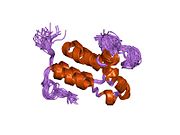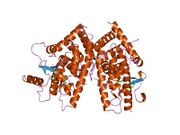Biology:Nuclear receptor coactivator 1
From HandWiki
Short description: Protein-coding gene in the species Homo sapiens
 Generic protein structure example |
The nuclear receptor coactivator 1 (NCOA1), also called steroid receptor coactivator-1 (SRC-1), is a transcriptional coregulatory protein that contains several nuclear receptor–interacting domains and possesses intrinsic histone acetyltransferase activity.[1][2] It is encoded by the gene NCOA1.[3]
NCOA1 is recruited to DNA promoter sites by ligand-activated nuclear receptors. NCOA1, in turn, acylates histones, which makes downstream DNA more accessible to transcription. Hence, NCOA1 assists nuclear receptors in the upregulation of DNA expression as a coactivator.[1][2]
Interactions
Nuclear receptor coactivator 1 possesses a basic helix-loop-helix (bHLH) domain and has been shown to interact with:
- Androgen receptor,[4][5][6]
- C-Fos,[7][8]
- C-jun,[7][8][9]
- CIITA,[10]
- CREB-binding protein,[11][12]
- Cyclin D1,[13]
- DDX17,[14]
- DDX5[14] and
- Estrogen receptor alpha,[11][14][15][16][17]
- Glucocorticoid receptor,[18][19]
- NFKB1,[7][20]
- PCAF,[21]
- PPARGC1A,[22]
- Peroxisome proliferator-activated receptor alpha,[23][24]
- SNW1,[25]
- STAT3,[26]
- STAT6,[27][28]
- TRIP4,[29] and
- Thyroid hormone receptor beta.[30][31]
References
- ↑ 1.0 1.1 "Sequence and characterization of a coactivator for the steroid hormone receptor superfamily". Science 270 (5240): 1354–1357. 1995. doi:10.1126/science.270.5240.1354. PMID 7481822. Bibcode: 1995Sci...270.1354O.
- ↑ 2.0 2.1 "The steroid receptor coactivator-1 contains multiple receptor interacting and activation domains that cooperatively enhance the activation function 1 (AF1) and AF2 domains of steroid receptors". Journal of Biological Chemistry 273 (20): 12101–12108. 1998. doi:10.1074/jbc.273.20.12101. PMID 9575154.
- ↑ "NCOA1 Gene - Nuclear Receptor Coactivator 1". 4 October 2023. https://www.genecards.org/cgi-bin/carddisp.pl?gene=NCOA1.
- ↑ "Recruitment of beta-catenin by wild-type or mutant androgen receptors correlates with ligand-stimulated growth of prostate cancer cells". Molecular Endocrinology 18 (10): 2388–2401. Oct 2004. doi:10.1210/me.2003-0436. PMID 15256534.
- ↑ "Ligand-independent activation of the androgen receptor by interleukin-6 and the role of steroid receptor coactivator-1 in prostate cancer cells". Journal of Biological Chemistry 277 (41): 38087–38094. Oct 2002. doi:10.1074/jbc.M203313200. PMID 12163482.
- ↑ "The AF1 and AF2 domains of the androgen receptor interact with distinct regions of SRC1". Molecular and Cellular Biology 19 (12): 8383–8392. Dec 1999. doi:10.1128/mcb.19.12.8383. PMID 10567563.
- ↑ 7.0 7.1 7.2 "Activating protein-1, nuclear factor-kappaB, and serum response factor as novel target molecules of the cancer-amplified transcription coactivator ASC-2". Molecular Endocrinology 14 (6): 915–925. Jun 2000. doi:10.1210/mend.14.6.0471. PMID 10847592.
- ↑ 8.0 8.1 "Steroid receptor coactivator-1 coactivates activating protein-1-mediated transactivations through interaction with the c-Jun and c-Fos subunits". Journal of Biological Chemistry 273 (27): 16651–16654. Jul 1998. doi:10.1074/jbc.273.27.16651. PMID 9642216.
- ↑ "A nuclear factor, ASC-2, as a cancer-amplified transcriptional coactivator essential for ligand-dependent transactivation by nuclear receptors in vivo". Journal of Biological Chemistry 274 (48): 34283–34293. Nov 1999. doi:10.1074/jbc.274.48.34283. PMID 10567404.
- ↑ "Steroid receptor coactivator 1 links the steroid and interferon gamma response pathways". Molecular Endocrinology 17 (12): 2509–2518. Dec 2003. doi:10.1210/me.2002-0439. PMID 12933903.
- ↑ 11.0 11.1 "Analysis of the steroid receptor coactivator 1 (SRC1)-CREB binding protein interaction interface and its importance for the function of SRC1". Molecular and Cellular Biology 21 (1): 39–50. Jan 2001. doi:10.1128/MCB.21.1.39-50.2001. PMID 11113179.
- ↑ "Regulation of SRC-3 (pCIP/ACTR/AIB-1/RAC-3/TRAM-1) Coactivator activity by I kappa B kinase". Molecular and Cellular Biology 22 (10): 3549–3461. May 2002. doi:10.1128/MCB.22.10.3549-3561.2002. PMID 11971985.
- ↑ "Ligand-independent recruitment of steroid receptor coactivators to estrogen receptor by cyclin D1". Genes & Development 12 (22): 3488–3498. Nov 1998. doi:10.1101/gad.12.22.3488. PMID 9832502.
- ↑ 14.0 14.1 14.2 "A subfamily of RNA-binding DEAD-box proteins acts as an estrogen receptor alpha coactivator through the N-terminal activation domain (AF-1) with an RNA coactivator, SRA". EMBO Journal 20 (6): 1341–1352. Mar 2001. doi:10.1093/emboj/20.6.1341. PMID 11250900.
- ↑ "BRG-1 is recruited to estrogen-responsive promoters and cooperates with factors involved in histone acetylation". Molecular and Cellular Biology 20 (20): 7541–7549. Oct 2000. doi:10.1128/MCB.20.20.7541-7549.2000. PMID 11003650.
- ↑ "Isoforms of steroid receptor co-activator 1 differ in their ability to potentiate transcription by the oestrogen receptor". EMBO Journal 17 (1): 232–243. Jan 1998. doi:10.1093/emboj/17.1.232. PMID 9427757.
- ↑ "The TRAP/Mediator coactivator complex interacts directly with estrogen receptors alpha and beta through the TRAP220 subunit and directly enhances estrogen receptor function in vitro". Proceedings of the National Academy of Sciences, USA 99 (5): 2642–2647. Mar 2002. doi:10.1073/pnas.261715899. PMID 11867769. Bibcode: 2002PNAS...99.2642K.
- ↑ "Regulation of glucocorticoid receptor activity by 14--3-3-dependent intracellular relocalization of the corepressor RIP140". Molecular Endocrinology 15 (4): 501–511. Apr 2001. doi:10.1210/mend.15.4.0624. PMID 11266503.
- ↑ "A point mutation of the AF2 transactivation domain of the glucocorticoid receptor disrupts its interaction with steroid receptor coactivator 1". Journal of Biological Chemistry 277 (29): 26098–260102. Jul 2002. doi:10.1074/jbc.M204013200. PMID 12118039.
- ↑ "Steroid receptor coactivator-1 interacts with the p50 subunit and coactivates nuclear factor kappaB-mediated transactivations". Journal of Biological Chemistry 273 (18): 10831–10834. May 1998. doi:10.1074/jbc.273.18.10831. PMID 9556555.
- ↑ "Steroid receptor coactivator-1 is a histone acetyltransferase". Nature 389 (6647): 194–198. Sep 1997. doi:10.1038/38304. PMID 9296499. Bibcode: 1997Natur.389..194S.
- ↑ "Activation of PPARgamma coactivator-1 through transcription factor docking". Science 286 (5443): 1368–1371. Nov 1999. doi:10.1126/science.286.5443.1368. PMID 10558993.
- ↑ "p300 functions as a coactivator for the peroxisome proliferator-activated receptor alpha". Journal of Biological Chemistry 272 (52): 33435–33443. Dec 1997. doi:10.1074/jbc.272.52.33435. PMID 9407140.
- ↑ "A regulatory role for RIP140 in nuclear receptor activation". Molecular Endocrinology 12 (6): 864–881. Jun 1998. doi:10.1210/mend.12.6.0123. PMID 9626662.
- ↑ "Ternary complexes and cooperative interplay between NCoA-62/Ski-interacting protein and steroid receptor coactivators in vitamin D receptor-mediated transcription". Journal of Biological Chemistry 276 (44): 40614–40620. Nov 2001. doi:10.1074/jbc.M106263200. PMID 11514567.
- ↑ "Functional interaction of STAT3 transcription factor with the coactivator NcoA/SRC1a". Journal of Biological Chemistry 277 (10): 8004–811. Mar 2002. doi:10.1074/jbc.M111486200. PMID 11773079.
- ↑ "Transcriptional activation by STAT6 requires the direct interaction with NCoA-1". Journal of Biological Chemistry 276 (49): 45713–45721. Dec 2001. doi:10.1074/jbc.M108132200. PMID 11574547.
- ↑ "An LXXLL motif in the transactivation domain of STAT6 mediates recruitment of NCoA-1/SRC-1". Journal of Biological Chemistry 277 (39): 36052–36060. Sep 2002. doi:10.1074/jbc.M203556200. PMID 12138096.
- ↑ "Activating signal cointegrator 1, a novel transcription coactivator of nuclear receptors, and its cytosolic localization under conditions of serum deprivation". Molecular and Cellular Biology 19 (9): 6323–6332. Sep 1999. doi:10.1128/mcb.19.9.6323. PMID 10454579.
- ↑ "Lack of coactivator interaction can be a mechanism for dominant negative activity by mutant thyroid hormone receptors". Endocrinology 139 (10): 4197–4204. Oct 1998. doi:10.1210/endo.139.10.6218. PMID 9751500.
- ↑ "Analysis of the functional role of steroid receptor coactivator-1 in ligand-induced transactivation by thyroid hormone receptor". Molecular Endocrinology 11 (6): 755–767. Jun 1997. doi:10.1210/mend.11.6.0003. PMID 9171239.
External links
- nuclear receptor coactivator 1 at the US National Library of Medicine Medical Subject Headings (MeSH)
- NURSA C89
Further reading
- "Peroxisome proliferator-activated receptors, coactivators, and downstream targets". Cell Biochemistry and Biophysics. 32 Spring (1–3): 187–204. 2001. doi:10.1385/cbb:32:1-3:187. PMID 11330046.
 |




